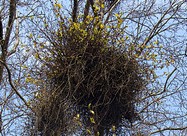 Witches broom is characterized by abnormal growth in a tree or shrub that results in multiple stems growing from a common point forming a mass of twigs that resemble a bird’s nest or witch’s broom. The problem is especially common on conifer and deciduous tree species but also occurs on shrubs. One or many witch’s brooms can occur on a single plant usually without significantly damaging the plant but often hurting the appearance of deciduous trees and shrubs in the winter when the leaves have fallen.
Witches broom is characterized by abnormal growth in a tree or shrub that results in multiple stems growing from a common point forming a mass of twigs that resemble a bird’s nest or witch’s broom. The problem is especially common on conifer and deciduous tree species but also occurs on shrubs. One or many witch’s brooms can occur on a single plant usually without significantly damaging the plant but often hurting the appearance of deciduous trees and shrubs in the winter when the leaves have fallen.
The causes of witches broom are many and varied. Causative organisms include, viruses, mycoplasms, phytoplasms, bacteria, mistletoes, fungi, oomycetes, mites, nematodes, and aphids. Some brooms, however, appear to be caused by environmental or biological stresses, or are the result of genetic mutations in the buds of the branches. Many dwarf conifers are the result of brooms caused by such genetic mutations.
There are numerous woody plants that may develop witch’s broom. Susceptible deciduous trees include alder, birch, Amelanchier, California buckeye, cherry, elm, hackberry, honey locust, oak, maple, and mulberry. Confers that may be effected include spruce, Chamaecyparis, juniper, red cedar, pine, and fir. Witches broom may also occur in shrubs such as rhododendron, cherry laurel, mountain heath, and manzanita, as well as in herbaceous plants such as potato, and strawberry. Since witch’s broom grows very slowly it can be controlled in most cases by being cut out. On the other hand, witch’s brooom causes considerable damage to the cocoa tree (Theobroma cacao), the timber tree Melia azedarach, and roses, and can result in the death of the plant.